A Chinese kin, lineage or sometimes rendered as clan, is a patrilineal and patrilocal group of related Chinese people with a common surname sharing a common ancestor and, in many cases, an ancestral home.

Chinese folk religion, also known as Chinese popular religion, comprehends a range of traditional religious practices of Han Chinese, including the Chinese diaspora. Vivienne Wee described it as "an empty bowl, which can variously be filled with the contents of institutionalised religions such as Buddhism, Taoism, Confucianism and Chinese syncretic religions”. This includes the veneration of shen (spirits) and ancestors, exorcism of demonic forces, and a belief in the rational order of nature, balance in the universe and reality that can be influenced by human beings and their rulers, as well as spirits and deities. Worship is devoted to deities and immortals, who can be deities of places or natural phenomena, of human behaviour, or founders of family lineages. Stories of these gods are collected into the body of Chinese mythology. By the Song dynasty (960–1279), these practices had been blended with Buddhist, Confucianist doctrines and Taoist teachings to form the popular religious system which has lasted in many ways until the present day. The present day government of mainland China, like the imperial dynasties, tolerates popular religious organizations if they bolster social stability but suppresses or persecutes those that they fear would undermine it.
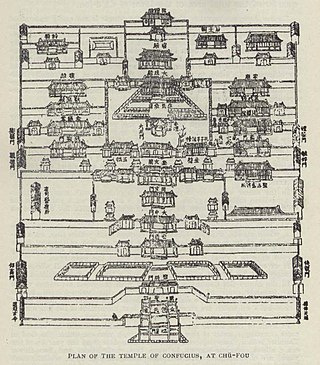
A temple of Confucius or Confucian temple is a temple for the veneration of Confucius and the sages and philosophers of Confucianism in Chinese folk religion and other East Asian religions. They were formerly the site of the administration of the imperial examination in China, Korea, Japan and Vietnam and often housed schools and other studying facilities.
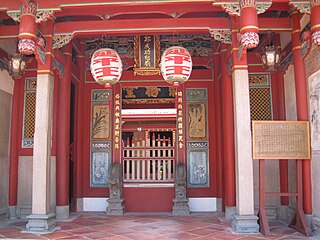
Koxinga Ancestral Shrine is a family shrine built in West Central District, Tainan, Taiwan in 1663 by Zheng Jing, to worship his father Koxinga.

Jongmyo (Korean: 종묘) is a Confucian shrine in the Jongno District of Seoul, South Korea. It was originally built during the Joseon period (1392–1897) for memorial services for deceased kings and queens. According to UNESCO, the shrine is the oldest royal Confucian shrine preserved and the ritual ceremonies continue a tradition established in the 14th century. Such shrines existed during the Three Kingdoms of Korea period (57–668), but these have not survived. The Jongmyo Shrine was added to the UNESCO World Heritage list in 1995.

The Imperial Ancestral Temple, or Taimiao of Beijing, is a historic site in the Imperial City, just outside the Forbidden City, where during both the Ming and Qing dynasties, sacrificial ceremonies were held on the most important festival occasions in honor of the imperial family's ancestors.

Chinese temple architecture refer to a type of structures used as place of worship of Chinese Buddhism, Taoism, Confucianism, or Chinese folk religion, where people revere ethnic Chinese gods and ancestors. They can be classified as:

Chinese ancestor veneration, also called Chinese ancestor worship, is an aspect of the Chinese traditional religion which revolves around the ritual celebration of the deified ancestors and tutelary deities of people with the same surname organised into lineage societies in ancestral shrines. Ancestors, their ghosts, or spirits, and gods are considered part of "this world". They are neither supernatural nor transcendent in the sense of being beyond nature. The ancestors are humans who have become godly beings, beings who keep their individual identities. For this reason, Chinese religion is founded on veneration of ancestors. Ancestors are believed to be a means of connection to the supreme power of Tian as they are considered embodiments or reproducers of the creative order of Heaven. It is a major aspect of Han Chinese religion, but the custom has also spread to ethnic minority groups.

The Temple of the Five Lords, also known as the "Temple of the Five Officials", is a memorial shrine to five exiled officials from the Tang and Song dynasties that is located to the southeast of the city of Haikou on the island of Hainan, China. During the times of these dynasties, Hainan was perceived as a remote part of the empire and was used as a place for banishment for disgraced court officials. All five officials worshipped at the temple encountered such a fate, typically after losing power struggles within the imperial court.

The Lukang Wen Wu Temple is a Wen Wu temple in Lukang Township, Changhua County, Taiwan.

The Zhong-Sheng-Gong Memorial is a memorial in Pingtung City, Pingtung County, Taiwan.

The Yang Family Ancestral Hall is an ancestral shrine in Jiadong Township, Pingtung County, Taiwan.

The Wukou Village Liou Family Ancestral Hall is an ancestral shrine in Wanluan Township, Pingtung County, Taiwan.
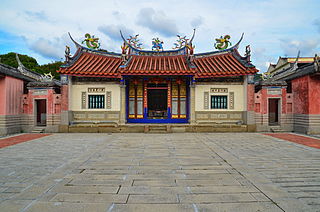
The Shetou Doushan Temple is an ancestral temple in Shetou Township, Changhua County, Taiwan.
The architecture of Taiwan can be traced back to stilt housing of the aborigines in prehistoric times; to the building of fortresses and churches in the north and south used to colonize and convert the inhabitants during the Dutch and Spanish period; the Tungning period when Taiwan was a base of anti-Qing sentiment and Minnan-style architecture was introduced; in Qing dynasty period, a mix of Chinese and Western architecture appeared and artillery battery flourished during Qing's Self-Strengthening Movement; During the Japanese rule of Taiwan, the Minnan, Japanese and Western culture were main influencers in architectural designs and saw the introduction and use of reinforced concrete. Due to excessive Westernization as a colony, after the retrocession of Taiwan to the Republic of China in 1945 from Japan at the end of World War II, Chinese classical style became popular and entered into international mainstream as a postmodern design style. Today, Taiwanese architecture has undergone much diversification, every style of architecture can be seen.
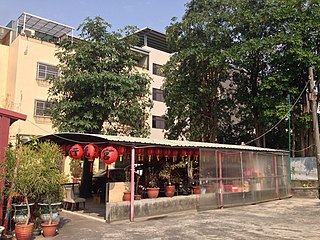
In Taiwanese folk religion, yin miao are temples dedicated to wandering and homeless spirits, as opposed to yang miao, which are dedicated to deities. According to local beliefs, ghosts without a permanent resting place wandering in the human realm and may cause trouble for the living. Therefore, yin miao serve as such resting places for these spirits as a form of respect and to maintain peace. Temples dedicated to deities associated with afterlife, like Cheng Huang Ye or Di Zang Wang, are not considered yin miao.

Wanyinggong Temple, commonly referred to as Princess Babao Temple, is a yin miao in Hengchun Township, Pingtung County, Taiwan. The temple is known for its worship an allegedly Dutch princess known as "Princess Babao".
A Zongmiao (宗廟) or Taimiao (太廟) is an ancient Chinese ancestral temple dedicated to the ancestors of nobles and monarchs and their spirit tablets. Zong (宗) means ancestral and Miao (廟) means temple. The earliest known Zongmiao was discovered at Yinxu Palace and Temple Site in Anyang, Henan Province, China, and is yet to be excavated. At that time, commoners did not have the right to set up ancestral shrines, "The Xunzi-Liturgy" reads: "Therefore, those who have the world serve seven generations, those who have a country serve five generations, those who have five times the land serve three generations, those who have three times the land serve two generations, those who hold their hands and eat are not allowed to set up a temple, so the thick accumulation of the flow of water is wide, and the thin accumulation of water is narrow. "
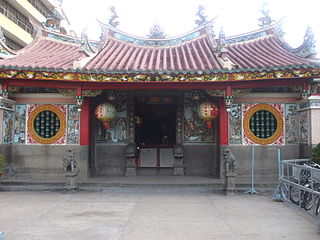
Miao (廟/庙) are buildings in traditional East Asian religions enshrining gods, myths or legends, sages of past dynasties, and famous historical figures. They are a kind of Chinese temple architecture and contrast with Ci Shrines which enshrine ancestors and people instead of deities.

A Ci shrine, (祠), is a semi-religious facility that originated in China and was widely used in the East Asian cultural sphere for traditional folk beliefs, mainly for the worship, sacrifice, deity, ancestor, or sage or martyr, in the form of a temple-style building.





























